 Japan has suffered from deflation on and off for more than 20 years. A problem with falling prices is that they discourage spending as people wait for prices to fall further. One of the three elements of the Japanese government’s macroeconomic policy (see Japan’s three arrows) has been expansionary monetary policy, including aggressive quantitative easing. A key aim of this is to achieve an inflation target of 2% and, hopefully, propel the economy out of its deflationary trap.
Japan has suffered from deflation on and off for more than 20 years. A problem with falling prices is that they discourage spending as people wait for prices to fall further. One of the three elements of the Japanese government’s macroeconomic policy (see Japan’s three arrows) has been expansionary monetary policy, including aggressive quantitative easing. A key aim of this is to achieve an inflation target of 2% and, hopefully, propel the economy out of its deflationary trap.
The latest news, therefore, from Japan would seem to be good: consumer prices rose 0.4% in June – the first rise for more than a year. But while some analysts see the rise in prices to be partly the result of a recovery in demand (i.e. demand-pull inflation), others claim that the inflation is largely of the cost-push variety as the weaker yen has increased the price of imported fuel and food.
 If Japanese recovery is to be sustained and broadly based, a growth in real wages should be a core component. As it is, real wages are not growing. This could seriously constrain the recovery. For real wages to grow, employers need to be convinced that economic recovery will be sustained and that it would be profitable to take on more labour.
If Japanese recovery is to be sustained and broadly based, a growth in real wages should be a core component. As it is, real wages are not growing. This could seriously constrain the recovery. For real wages to grow, employers need to be convinced that economic recovery will be sustained and that it would be profitable to take on more labour.
The success of the expansionary policy, therefore, depends in large part on its effect on expectations. Do people believe that prices will continue to rise? Do employers believe that the economy will continue to expand? And do people believe that their real wages will rise?
Articles
Japan prices turn higher, but BOJ’s goal remains tall order Reuters, Tetsushi Kajimoto and Leika Kihara (26/7/13)
How Japan Could Go from Deflation to Hyperinflation in a Heartbeat The Wall Street Journal, Michael J. Casey (24/7/13)
Japan Prices Rise Most Since ’08 in Boost for Abe Bloomberg, Toru Fujioka & Andy Sharp (26/7/13)
Japan central bank finds the pessimists come from within Reuters, Leika Kihara (26/7/13)
Japan’s Fiscal Crossroads: Will Abenomics Mean Tougher Changes? The Daily Beast, Daniel Gross (26/7/13)
Japan Economist Makes Rare Call to Tackle Debt The Wall Street Journal, Kosaku Narioka (25/7/13)
Japanese Consumer Prices Rise In Sign Of Some Success In Abe Economic Policy International Business Times, Nat Rudarakanchana (26/7/13)
Data
Bank of Japan Statistics Bank of Japan
Statistics Statistics Bureau of Japan
International sites for data Economics Network
Questions
- Distinguish between cost-push and demand-pull inflation? Do higher prices resulting from a depreciation of the currency always imply that the resulting inflation is of the cost-push variety?
- In the Japanese context, is inflation wholly desirable or are there any undesirable consequences?
- Consider whether a two-year time frame is realistic for the the Bank of Japan to achieve its 2% inflation target.
- What is meant by the output gap? Using sources such as the European Commission’s European Economy, AMECO database and the OECD’s Economic Outlook: Statistical Annex Tables (see sites 6 and 7 in the Economics Network’s links to Economic Data freely available online) trace the Japanese output gap over the past 10 years and comment on your findings.
- What supply-side constraints are likely to limit the rate and extent of recovery in Japan? What is the Japanese government doing about this (see the third arrow of Japan’s three arrows)?
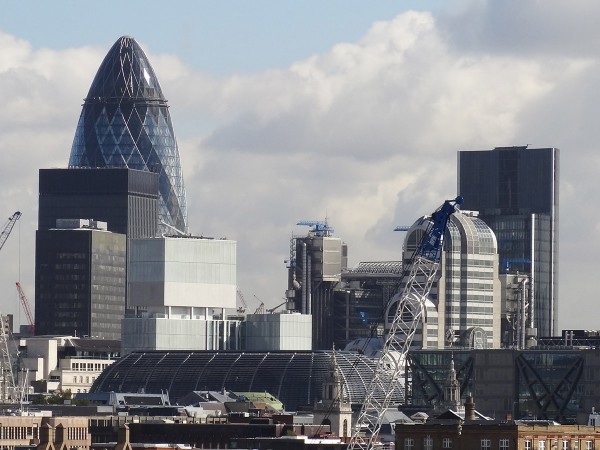 The Preliminary Estimate of the UK Q2 GDP figures by the Office for National Statistics show that the UK economy grew by 0.6% in the second quarter of 2013: double the growth rate of the first quarter and almost back to the long-run average growth rate prior to 2008.
The Preliminary Estimate of the UK Q2 GDP figures by the Office for National Statistics show that the UK economy grew by 0.6% in the second quarter of 2013: double the growth rate of the first quarter and almost back to the long-run average growth rate prior to 2008.
At first sight, this would seem to be good news – certainly from the government’s point of view. What is more, unlike the previous quarter, growth is spread relatively evenly across the three main sectors: the production (manufacturing, mining, water supply, etc.) and services sectors both grew by 0.6% and the construction sector by 0.9% (this sector fell by 1.8% in the previous quarter). (Click here for a PowerPoint of the chart below.)
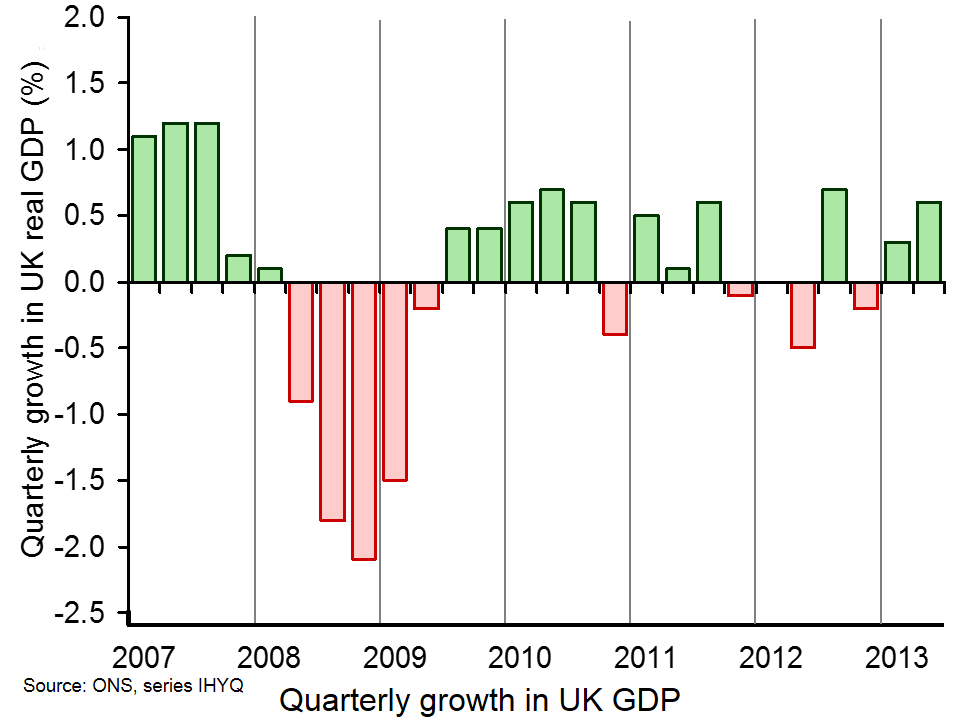 But while growth in the latest quarter may be balanced between the broad sectors, the rise in aggregate demand is not balanced between its components. As an earlier news item (A balancing act) showed, the rise in aggregate demand has been driven largely by a rise in consumption, and a corresponding fall in saving. Exports are rising only slowly and investment is some 25% lower than in the boom years prior to 2008.
But while growth in the latest quarter may be balanced between the broad sectors, the rise in aggregate demand is not balanced between its components. As an earlier news item (A balancing act) showed, the rise in aggregate demand has been driven largely by a rise in consumption, and a corresponding fall in saving. Exports are rising only slowly and investment is some 25% lower than in the boom years prior to 2008.
So will the latest growth be sustainable? Will investment now begin to pick up and what constraints are there on investment? The following articles consider some of the issues.
Articles
Economy firing on all cylinders as growth hits 0.6pc The Telegraph, Philip Aldrick (25/7/13)
The good, the bad or the ugly? How the UK economy stands up. The Telegraph, Philip Aldrick (25/7/13)
George Osborne’s 0.6% growth is good but unspectacular The Guardian, Larry Elliott (25/7/13)
The (not-so) green shoots of recovery The Economist, John Van Reenen (23/7/13)
Economic recovery slow to take root for some in UK Reuters, William Schomberg and Max De Haldevang (25/7/13)
 GDP figures offer hard evidence for political narrative BBC News, Paul Mason (25/7/13)
GDP figures offer hard evidence for political narrative BBC News, Paul Mason (25/7/13)
Ignore the hype: Britain’s ‘recovery’ is a fantasy that hides our weakness The Observer, Will Hutton (21/7/13)
UK economy: Half-speed ahead BBC News, Stephanie Flanders (25/7/13)
BoE guidance can help sustain the UK recovery The Economist, Kevin Daly (22/7/13)
George Osborne’s description of the economy is near-Orwellian The Guardian, Ha-Joon Chang (26/7/13)
Economic growth: more must be done to encourage investment The Guardian, Phillip Inman (1/8/13)
Data
Gross Domestic Product: Preliminary Estimate, Q2 2013 ONS (25/7/13)
Questions
- Compare the macroeconomic situation today with that prior to the financial crisis of 2007/8 and subsequent recession.
- What factors will determine the sustainability of the UK economic recovery?
- What is meant by the ‘accelerator’ and what will determine the size of any accelerator effect from the latest rise in UK GDP?
- What supply-side constraints are likely to limit the rate and extent of recovery?
- Why do economies that are in recession ‘naturally bounce back’ without any government intervention? Have the macroeconomic policies of the UK government helped or hindered this bounce back? Explain.
- What monetary measures by the Bank of England are most appropriate in the current circumstances?
 There’s some good news and some bad news about the UK economy. The good news is that there are signs that the recovery is gathering momentum; the ‘green shoots’ are growing bigger. The bad news is that it’s the ‘wrong type of growth’!
There’s some good news and some bad news about the UK economy. The good news is that there are signs that the recovery is gathering momentum; the ‘green shoots’ are growing bigger. The bad news is that it’s the ‘wrong type of growth’!
One of the main underlying problems of the 2008 financial crisis was that household debt had been increasing to unsustainable levels, egged on by banks only too willing to lend, whether as personal loans, on credit cards or through mortgages. When the recession hit, many people sought to reduce their debts by cutting back on spending. This further fuelled the recession.
What the government and most economists hoped was that there would be some rebalancing of the economy, with less reliance on consumer spending to drive economic growth. Instead it was hoped that growth would be driven by a rise in investment and exports. Indeed, the 25% depreciation of sterling exchange between 2007 and 2009 was seen as a major advantage as this would boost the demand for exports and encourage firms to invest in the export sector.
But things haven’t turned out the way people hoped. The recession (or lack of growth) has been much deeper and more prolonged than previous downturns in the economy. Today, real GDP per head is more than 7% below the level in 2007 and many people have seen much bigger declines in their living standards.
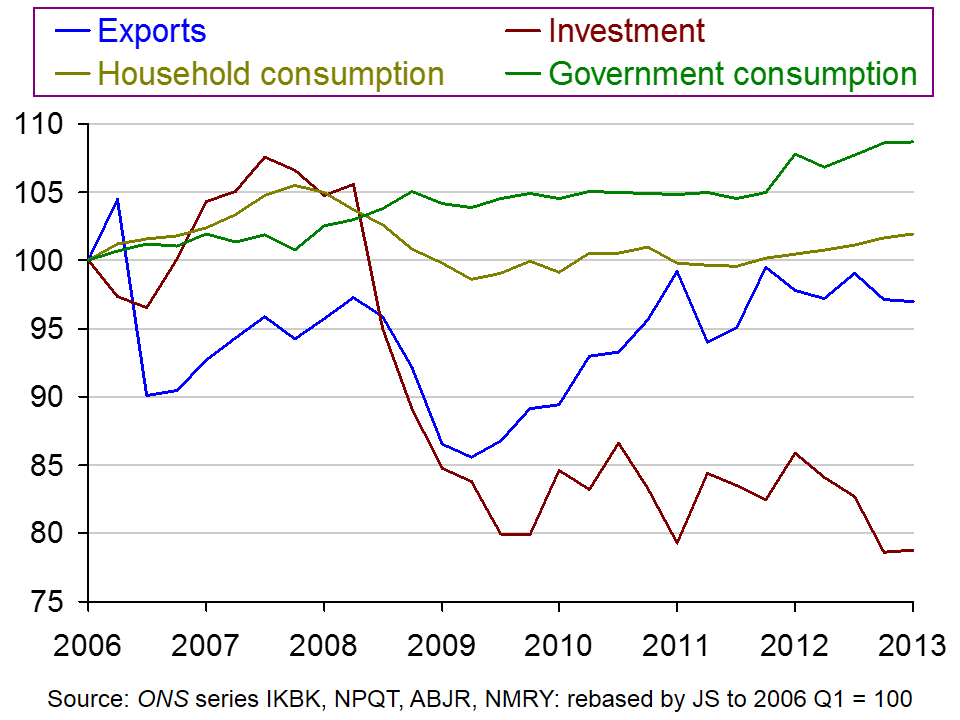 But also, despite the austerity policies, the economy has not been ‘rebalanced’ towards exports and investment. Exports are 3% lower than in 2006 (although they did grow between 2009 Q2 and 2011 Q1, but have since stagnated). And investment is 27% lower than in 2006. Household consumption, however, has grown by about 2% and general government consumption by around 9% since 2006. The chart shows the figures, based on 2006 Q1 = 100.
But also, despite the austerity policies, the economy has not been ‘rebalanced’ towards exports and investment. Exports are 3% lower than in 2006 (although they did grow between 2009 Q2 and 2011 Q1, but have since stagnated). And investment is 27% lower than in 2006. Household consumption, however, has grown by about 2% and general government consumption by around 9% since 2006. The chart shows the figures, based on 2006 Q1 = 100.
(Click here for a PowerPoint of the chart.)
And recent evidence is that consumption is beginning to grow faster – not because of rising household incomes, but because of falling saving rates. In 2008, the household saving ratio had fallen to nearly 0% (i.e. households were on average saving about the same as they were borrowing). Then the saving ratio rose dramatically as people reined in their spending. Between 2009 and 2012, the ratio hovered around 7%. But in the first quarter of 2013, it had fallen to 4.2%
So the good news is that aggregate demand is rising, boosting economic growth. But the bad news is that, at least for the time being, this growth is being driven by a rise in household borrowing and a fall in household saving. The videos and articles consider whether this is, however, still good news on balance.
Webcasts
 Britain’s imbalanced economy The Economist, Zanny Minton Beddoes and Richard Davies (4/7/13)
Britain’s imbalanced economy The Economist, Zanny Minton Beddoes and Richard Davies (4/7/13)
 Britain’s Export Drought: an enduring disappointment The Economist, Andrew Palmer and Richard Davies (9/2/13)
Britain’s Export Drought: an enduring disappointment The Economist, Andrew Palmer and Richard Davies (9/2/13)
 ‘Green shoots’ of economic recovery in Rugby BBC News, Paul Mason (12/6/13)
‘Green shoots’ of economic recovery in Rugby BBC News, Paul Mason (12/6/13)
Articles
Is the UK economy seeing the ‘wrong kind’ of green shoots? BBC News, Stephanie Flanders (3/7/13)
The export drought: Better out than in The Economist (9/2/13)
Exports and the economy: Made in Britain The Economist (21/1/12)
The economy: On a wing and a credit card The Economist (6/7/13)
Unbalanced and unsustainable – this is the wrong kind of growth The Telegraph, Jeremy Warner (8/7/13)
The UK economy’s looking up – but no one’s told manufacturers The Guardian, Heather Stewart (10/7/13)
Data
Quarterly National Accounts, Q1 2013 (27/6/13)
Forecasts for the UK economy: a comparison of independent forecasts HM Treasury (June 2013)
ISM Manufacturing Report on Business® PMI History Institute for Supply Management
Questions
- What are forecasters expecting to happen to economic growth in the coming months? Why?
- What factors determine investment? Why has it fallen so substantially in the UK?
- Explain what is meant by the ‘accelerator’. Is the rise in consumption likely to lead to an accelerator effect and, if so, what will determine the size of this effect?
- Why have exports not grown more rapidly despite the depreciation of sterling after 2007?
- What will determine the rate of potential economic growth in the UK economy? How will a rise in real GDP driven by a rise in consumption impact on potential GDP and potential economic growth?
- What supply-side policies would you recommend, and why, in order to increase potential economic growth?
 Comet, Peacocks, Woolworths, JJB, Jessops and now HMV – they all have one thing in common. The recession has hit them so hard that they entered administration. HMV is the latest high street retailer to bring in the administrators, despite insisting that it does have a future on the UK’s high streets. With debts of £176m and huge competition from online retailers, the future of HMV is very uncertain.
Comet, Peacocks, Woolworths, JJB, Jessops and now HMV – they all have one thing in common. The recession has hit them so hard that they entered administration. HMV is the latest high street retailer to bring in the administrators, despite insisting that it does have a future on the UK’s high streets. With debts of £176m and huge competition from online retailers, the future of HMV is very uncertain.
Over the past decades, companies such as Amazon, ebay, LoveFilm, Netflix and apple have emerged providing very stiff competition to the last remaining high street seller of music and DVDs. People have been turning more and more to the internet to do their shopping, with cheaper prices and greater choice. The speed of delivery, which in the past may have been a disadvantage of buying from somewhere like Amazon, is now barely an obstacle and these substitute companies have created a difficult environment for high street retailers to compete in. Despite going into administration, it’s not necessarily the end of the much-loved HMV. Its Chief Executive said:
We remain convinced we can find a successful business outcomes. We want to make sure it remains on the high street … We know our customers fell the same way.
 While the recession has undoubtedly affected sales at HMV, is this the main reason for its demise or are other factors more relevant? As discussed, online retailers have taken over the DVD and music industry and with downloading increasing in popularity and CD/DVDs on sale in numerous locations, including supermarket chains, HMV has felt the competitive pressure and its place on the high street has come into question. As Neil Saunders, the Managing Director of Conlumino said:
While the recession has undoubtedly affected sales at HMV, is this the main reason for its demise or are other factors more relevant? As discussed, online retailers have taken over the DVD and music industry and with downloading increasing in popularity and CD/DVDs on sale in numerous locations, including supermarket chains, HMV has felt the competitive pressure and its place on the high street has come into question. As Neil Saunders, the Managing Director of Conlumino said:
By our own figures, we forecast that by the end of 2015 some 90.4 per cent of music and film sales will be online. The bottom line is that there is no real future for physical retail in the music sector.
Further to this, prices have been forced downwards and HMV, having to pay high fixed costs to retain their place on the high streets, have been unable to compete and remain profitable. Another contributing factor could be an outdated management structure, which has not responded to the changing times. Whatever the cause, thousands of jobs have been put at risk. Even if buyers are found, some store closures by the administrators, Deloitte, seem inevitable. Customer gift vouchers have already become worthless and further losses to both workers and customers seem likely. It is thought that there will be many interested buyers and huge support from suppliers, but the former is likely to remain a relatively secretive area for some time.

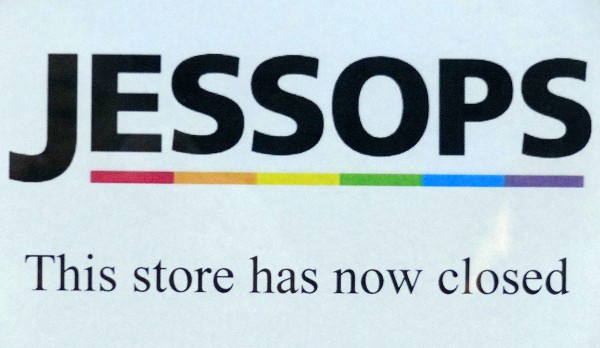 This latest high street disaster will undoubtedly raise many questions. One theory about recovery from a recession looks at the need for many businesses to go under until the fittest are left and there is sufficient scope for new businesses to emerge.
This latest high street disaster will undoubtedly raise many questions. One theory about recovery from a recession looks at the need for many businesses to go under until the fittest are left and there is sufficient scope for new businesses to emerge.
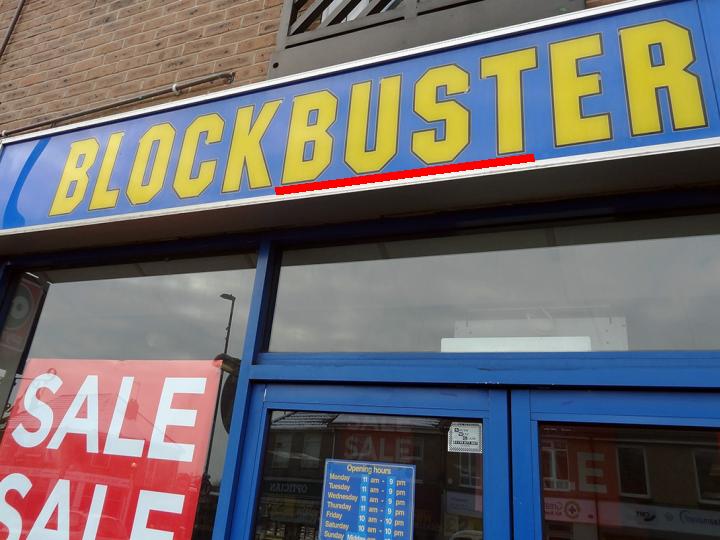 Could it be that the collapse of companies such as Woolworths, HMV, Comet, Jessops and Blockbuster is an essential requirement for economic recovery? Or was the recession irrelevant for HMV? Was its collapse an inevitable consequence of the changing face of Britain’s high streets and if so, what does the future hold for the high street retailers? The following articles consider the demise of HMV.
Could it be that the collapse of companies such as Woolworths, HMV, Comet, Jessops and Blockbuster is an essential requirement for economic recovery? Or was the recession irrelevant for HMV? Was its collapse an inevitable consequence of the changing face of Britain’s high streets and if so, what does the future hold for the high street retailers? The following articles consider the demise of HMV.
HMV: a visual history BBC News (15/1/13)
Chief executive says ‘HMV still has a place on the high street’, as customers are told their gift vouchers are worthless Independent, James Thompson (15/1/13)
Potential buyers circle stricken HMV Financial Times, Andrea Felsted (15/1/13)
HMV and independents to urged to work together to save in-store music market BBC News, Clive Lindsay (15/1/13)
HMV record chain was besest by digital downloads and cheap DVDs The Guardian (15/1/13)
The death of traditional retailers like HMV started when we caught on to one-click and the joy of owning DVDs wore thin Independent, Grace Dent (15/1/13)
HMV shoppers: ‘I’m disappointed, but it’s understandable why they went bust The Guardian, James Brilliant (15/1/13)
HMV: Record labels could take HMV back to its 1920 roots The Telegraph, Graham Ruddick (15/1/13)
HMV’s future seen as handful of stores and website Reuters, Neil Maidment and James Davey (15/1/13)
HMV leaves social gap in high street BBC News, Robert Plummer (15/1/13)
Is there good news in HMV’s collapse? BBC News, Robert Peston (15/1/13)
Is it game over for UK retail? The Guardian, Larry Elliott (18/1/13)
High Street retailers: Who has been hit hardest? BBC News (16/1/13)
Questions
- What are the main reasons behind the collapse of HMV?
- Use a diagram to illustrate the impact the companies such as Amazon and Tesco have had on costs and prices in the entertainment industry.
- Has the value we place on owning DVDs truly changed or have other factors led to larger purchases of online entertainment?
- Why is online retail providing such steep competition to high street retailers?
- Explain why it can be argued that economic recovery will only take place after a certain number of businesses have gone into administration.
- To what extent do you think HMV’s collapse is due to its failure to adapt to changing social circumstances?
- Briefly outline the wider economic implications of the collapse of a company such as HMV. Think about managers, employees, suppliers, customers and other competitors, as well as other high street retailers.
- In which market structure would you place the entertainment industry? Explain your answer. Has this contributed to the demise of HMV?
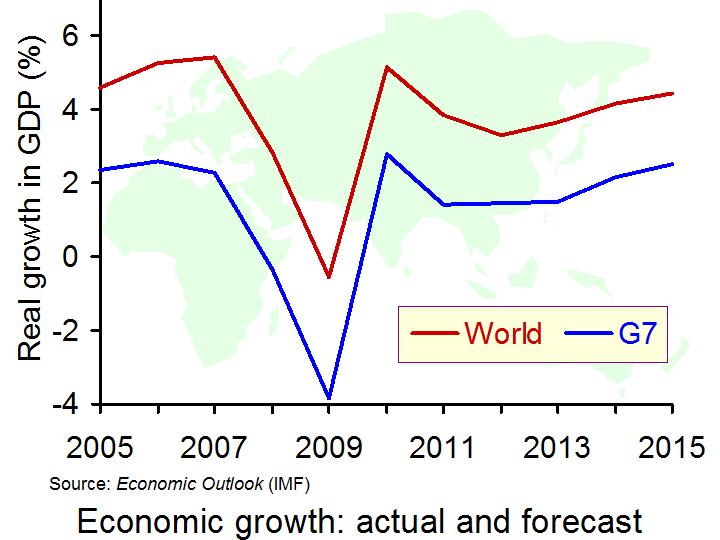 While the Western world has struggled with economic growth for the past 6 years, emerging economies such as China, Brazil and India have recorded some very high rates of growth. Throughout 2012, there were signs that these economies were not going to be the saviour of the global economy that we all thought. But, as we enter 2013, is it these economies that still hold the hope of the West for more positive figures and better economic times?
While the Western world has struggled with economic growth for the past 6 years, emerging economies such as China, Brazil and India have recorded some very high rates of growth. Throughout 2012, there were signs that these economies were not going to be the saviour of the global economy that we all thought. But, as we enter 2013, is it these economies that still hold the hope of the West for more positive figures and better economic times?
The article below from BBC News, in particular, considers the year ahead for the Asian economies and what it might mean for the Western world. Although these countries are by no means safeguarded against the impending approach of the US economy to their fiscal cliff or the ongoing eurozone crisis, they have seemed to be more insulated than the rest of the world. A crucial question to consider is whether this will continue. Furthermore, are the growth levels and policies of a country such as China sustainable? Can it continue to record such high growth rates in the face of the global economic situation?
The Japanese economy has been in serious trouble for a couple of decades, but measures to boost growth for this economy are expected. If these do occur, then western economies may feel some of their positive effects. At present, there is a degree of optimism as we enter the New Year, but how long this will last is anybody’s guess. The following articles consider the year ahead.
Asian economies face regional and global challenges BBC News (1/1/13)
Asia faces hard road ahead China Daily, Haruhiko Kuroda and Changyong Rhee (31/12/12)
Asia to continue rise despite US fiscal cliff Economic Times, Sugata Ghosh (1/1/13)
‘3.6% growth’ for global economy next year China Daily, Alvin Foo (28/12/12)
Asian economies surge ahead despite global slowdown Coast Week, Ding Qilin and Hu Junxin (4/1/13)
Global grind The Economist, Robin Bew (21/11/12)
Questions
- Why have the Asian economies been more insulated to the global economic conditions over the past few years, in comparison with the Western world?
- What challenges will the global economy be facing over the coming year?
- What challenges are the Asian economies facing? How different are they from the challenges you identified in question 3?
- Why is the rate of exchange an important factor for an economy such as Japan?
- What does a low exchange rate for the yen mean for European countries? Is it likely to be seen as a good or bad thing? What about for South Korea? Use a diagram to help you answer this question.
- Why is the economic situation in countries such as China and India so important for the rest of the global economy? Use a diagram to illustrate this.
 Japan has suffered from deflation on and off for more than 20 years. A problem with falling prices is that they discourage spending as people wait for prices to fall further. One of the three elements of the Japanese government’s macroeconomic policy (see Japan’s three arrows) has been expansionary monetary policy, including aggressive quantitative easing. A key aim of this is to achieve an inflation target of 2% and, hopefully, propel the economy out of its deflationary trap.
Japan has suffered from deflation on and off for more than 20 years. A problem with falling prices is that they discourage spending as people wait for prices to fall further. One of the three elements of the Japanese government’s macroeconomic policy (see Japan’s three arrows) has been expansionary monetary policy, including aggressive quantitative easing. A key aim of this is to achieve an inflation target of 2% and, hopefully, propel the economy out of its deflationary trap. If Japanese recovery is to be sustained and broadly based, a growth in real wages should be a core component. As it is, real wages are not growing. This could seriously constrain the recovery. For real wages to grow, employers need to be convinced that economic recovery will be sustained and that it would be profitable to take on more labour.
If Japanese recovery is to be sustained and broadly based, a growth in real wages should be a core component. As it is, real wages are not growing. This could seriously constrain the recovery. For real wages to grow, employers need to be convinced that economic recovery will be sustained and that it would be profitable to take on more labour.









